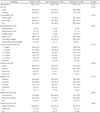Abstract
Objectives
The aim of this study was to investigate various factors associated with the willingness to visit psychiatric clinics among the general adult population in Bucheon city, South Korea.
Methods
One thousand seventy-five adults completed a self-questionnaire assessing their willingness to visit psychiatric clinics, family history of mental illnesses, frequency of contact with the mentally ill, stigma and discrimination toward the mentally ill, and the Community Attitude toward the Mentally Ill (CAMI). Logistic regression analyses were performed to identify variables associated with the willingness to visit psychiatric clinics.
Results
Study results showed that being single was associated with reduced willingness to visit psychiatric clinics. Subjects who had more frequent contact with mentally ill patients were more willing to visit psychiatric clinics. Concerning the CAMI scale, higher scores in authoritarianism and lower scores in benevolence subscales were associated with greater willingness to visit psychiatric clinic. Subjects who strongly admitted the existence of the stigma, and discrimination, toward mentally ill patients were more willing to visit psychiatric clinics.
Figures and Tables
Table 1
General characteristics of the subjects by willingness to visit psychiatric clinic

Data were reported as mean±standard deviation for continuous variables and n (%) for categorical variables. p-values were calculated by Student's t-test for continuous variables and chi-square test for categorical variables. * : White collar : professional, managerial, administrative work/blue collar : manufacturing, mechanic, service work, † : Statistically significant difference with a p-value less than 0.05
References
1. Ministry of Health and Welfare, Samsung Medical Center. The survey of mental disorders in Korea 2016. Ministry of Health and Welfare;2017.
2. Lee HY, Hwang IK, Yu JM. Treatment methods before psychiatric admission. J Korean Neuropsychiatr Assoc. 1973; 12:59–69.
3. Hyun MY, Yang S, Lee G. Survey for community attitudes toward people with mental illness. J Korean Acad Nurs. 2009; 39:84–94.

4. Kim HS. Stereotyopes, prejudice and the interpersonal relationship. Ewha J Soc Sciences. 2002; 12:83–101.
5. Kim HH, Kim JY, Lee MH, Jeong SH. Effect of human rights sensitivity and social distance on attitude toward mental illness in psychiatric hospital orderlies. J Korean Acad Psychiatr Ment Health Nurs. 2016; 25:249–261.

6. Sakong JK, Song CJ, Sohn IK. A study on the health personnels attitudes toward the mentally ill. Dongguk J Nat Sci. 2000; 39:217–236.
7. Seo SJ, Kwon HJ, Choi KS. A study on the attitudes of nurses in psychiatric ward towards mental disorder. Chung Ang J Med. 1991; 16:525–540.
8. Jang MY, Shin SH. Care burden for mental illness patients, attitude toward mental illness and psychiatric nursing competency in non-psychiatric nurses. J Korean Acad Psychiatr Ment Health Nurs. 2017; 26:55–66.

9. Ryu SH, Lee YH. The nonpsychiatric physicians’ attitudes and opinions toward psychiatry. J Korean Soc Biol Ther Psychiatry. 2001; 7:120–129.
10. Kim HL, Moon KH, Park JH, Song YJ, Yoon HM, Lee SY, et al. A comparative study of the nursing students and of the non-nursing students of their mental illness knowledge and in their attitudes toward the mental illness. J Nurs Acad Assoc Ewha Womans Univ. 2014; 48:63–79.
11. Choi G, Choi EJ. Attitudes of elementary school teachers toward mental illness. J Korean Acad Psychiatr Ment Health Nurs. 2015; 24:107–115.

12. Jang HS, Kim SU, Jang SM, Sung YH, Suh TW, Cho MJ. A study of attitudes toward the mentally ill in an urban area in Korea: a comparison between community residents and public officers. J Korean Assoc Soc Psychiatry. 2002; 7:103–115.
13. Noh CH. The attitudes of community leaders toward mental illness. J Korean Acad Nurs. 1998; 28:881–892.

14. Lee JE, Lee YM, Lim KY, Lee HY. A survey for community attitudes toward the mentally-ill in Ansan area. J Korean Neuropsychiatr Assoc. 1999; 38:530–538.
15. Ko Y, Shin SK, Hwang TY, Rhee CS, Park YS, Kim IS, et al. A study of attitudes toward mentally ill in Seong Nam community. Bull Yong-In Psychiatr Inst. 1999; 6:35–53.
16. Kang MK, Lee YK. Related factors to attitude and conception of community toward the mental illness. J Korea Acad Ind Coop Soc. 2014; 15:291–298.

17. Byun EK, Jun SS. Survey for attitudes toward the mentally ill and community mental health in a community area. Glob Health Nurs. 2011; 1:17–25.
18. Kim YN, Seo JM. Effects of mental illness education using movies on perceptions and attitudes of middle and high school teachers toward mental illness. J Korean Acad Psychiatr Ment Health Nurs. 2010; 19:382–390.

19. Jung KH, Sim DS, Lee CS. The effect of mental illness education on the attitudes toward mental illness of high school students. J Korean Acad Psychiatr Ment Health Nurs. 1999; 8:355–368.
20. Choi YM, Kim YM, Lee JH, Lee GC, Jun SI. Influences of lecture of mental disorders on the opinions and attitudes of protestants. Inje Med J. 1999; 20:207–212.
21. Taylor SM, Dear MJ. Scaling community attitudes toward the mentally ill. Schizophr Bull. 1981; 7:225–240.

22. Lee JH, Rhee CS, Hwang TY, Han KS, Lee YM. Community attitude toward the mentally ill in Suseo-Ilweon community. Bull Yong-In Psychiatr Inst. 1996; 3:188–202.
23. Bucheon City. Bucheon City basic statics 2014 vol. 41. Bucheon: Bucheon City;2015.
24. Department of Health (United Kingdom). Attitudes to mental illness 2014 research report: prepared for time to change. London: TNS BMRB;2015.
25. Wang PS, Lane M, Olfson M, Pincus HA, Wells KB, Kessler RC. Twelve-month use of mental health services in the United States: results from the National Comorbidity Survey Replication. Arch Gen Psychiatry. 2005; 62:629–640.

26. Seol KO, Park JE, Park SY. Religiosity and mental health: a meta-analytic review (1995-2011). Korean J Psychol Gen. 2012; 31:617–642.
27. Kim KI. Psychiatry in Korea for 21 Century: quo vadis? J Korean Neuropsychiatr Assoc. 1999; 38:5–11.
28. Kim KI. Acculturation and new religion in Korea. Ment Health Res. 1998; 17:90–96.
29. Ji EH. The attitudes toward the mentally ill and the knowledge about community mental health in a mixed region of urban and rural community [dissertation]. Chuncheon: Hallym university;2008.




 PDF
PDF ePub
ePub Citation
Citation Print
Print




 XML Download
XML Download